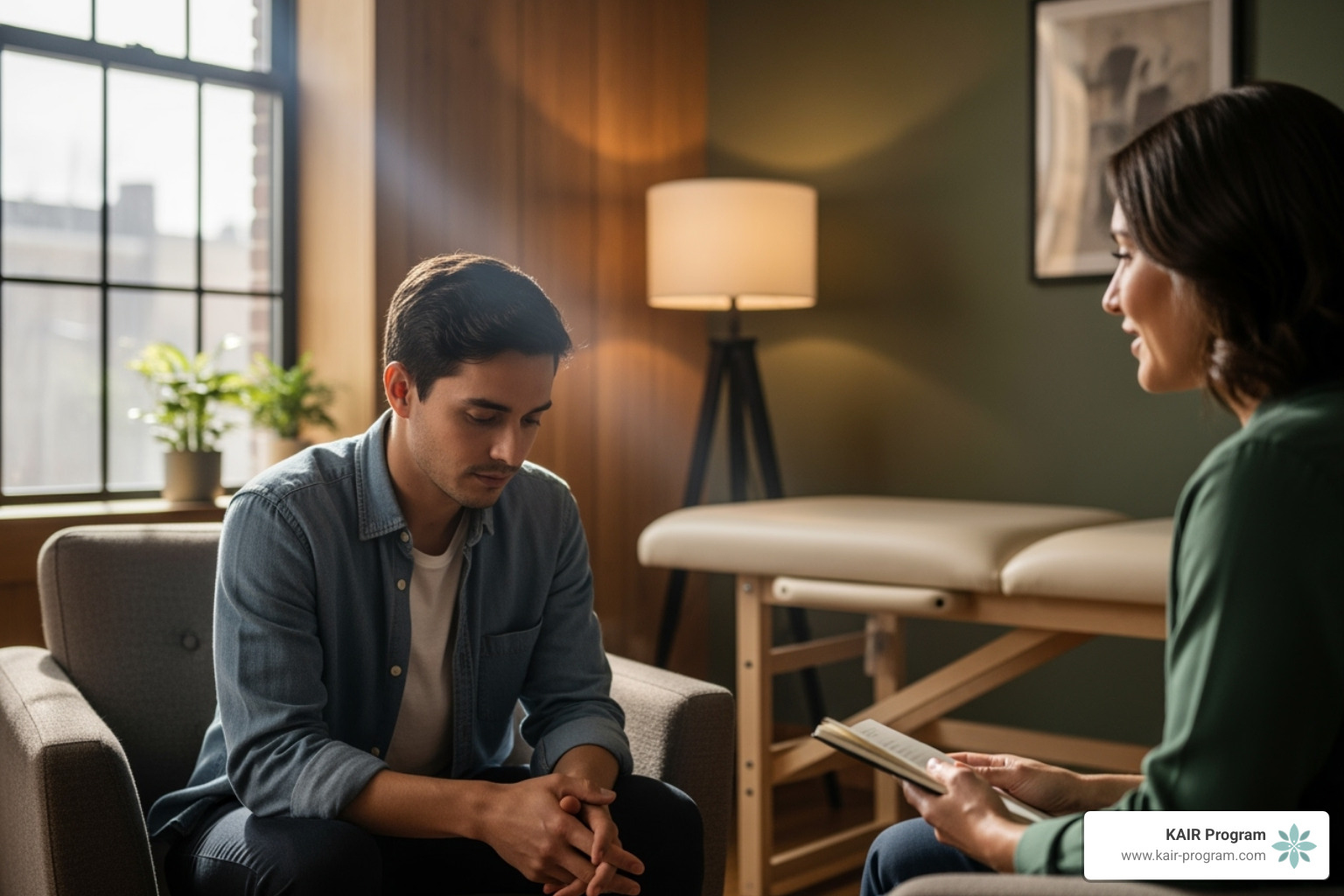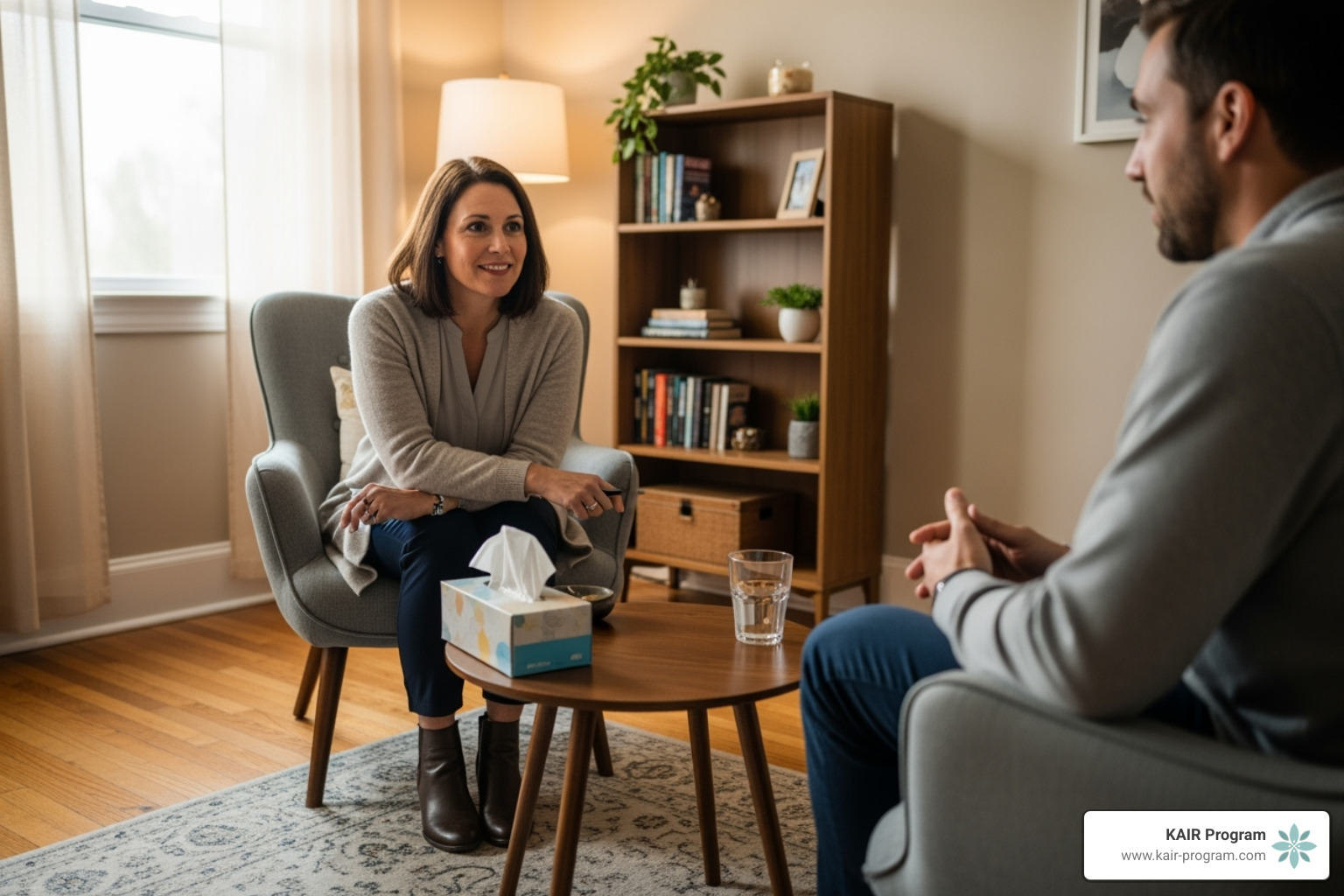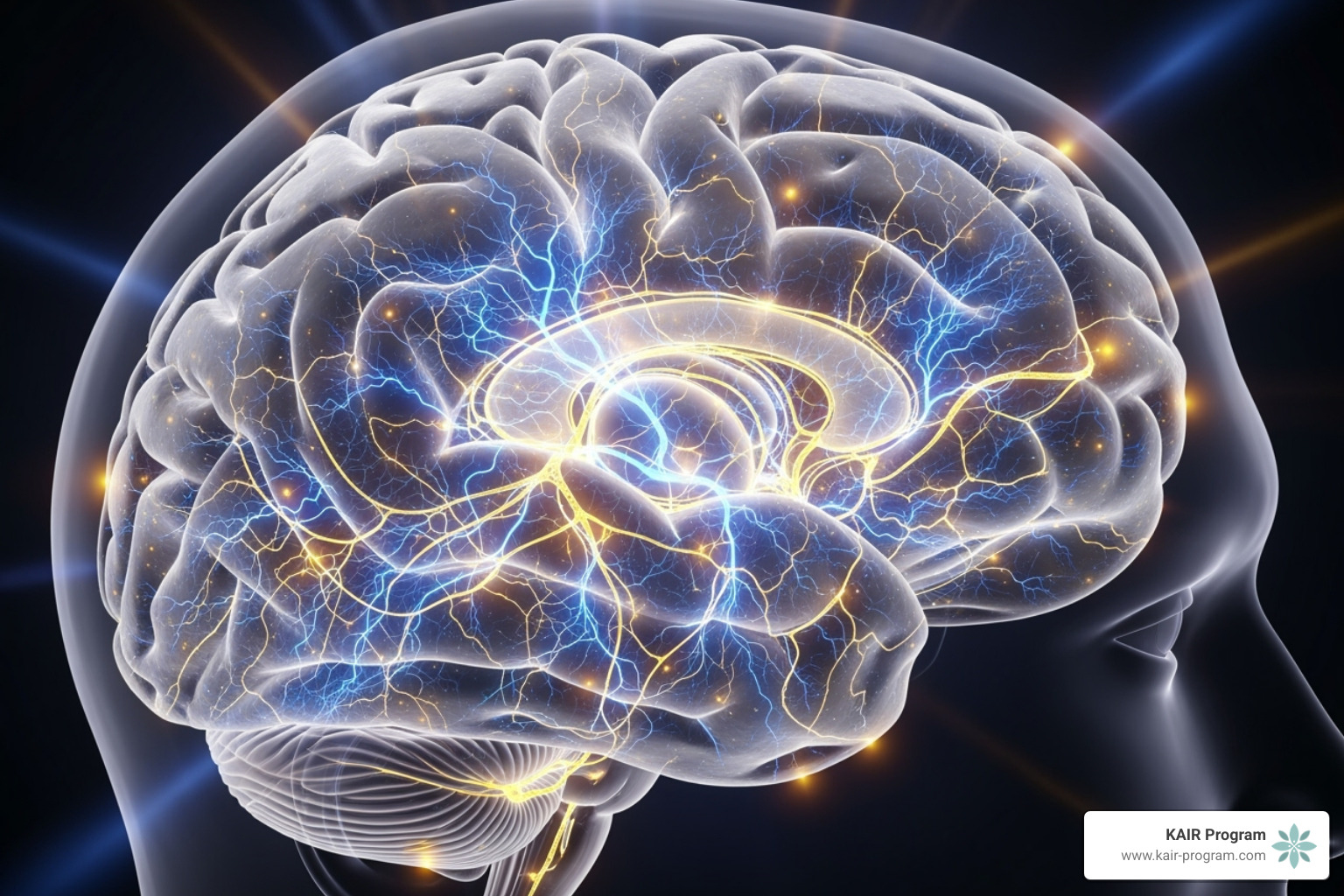When Sadness Runs Deep: Therapy for Severe Depression Explained
Understanding Your Options for Therapy for Severe Depression

Therapy for severe depression offers multiple evidence-based pathways to healing, from traditional psychotherapy to innovative brain stimulation and intensive therapy models.
Quick Overview of Therapy Options for Severe Depression:
- Standard Psychotherapy: Cognitive Behavioral Therapy (CBT), Dialectical Behavioral Therapy (DBT), and Interpersonal Therapy (IPT) - typically 8-16 sessions
- Combination Therapy: Psychotherapy plus medication (most effective for severe cases)
- Advanced Treatments: Brain stimulation therapies (ECT, TMS), ketamine-assisted therapy for treatment-resistant cases
- Intensive Models: Multi-day therapy retreats and accelerated treatment programs
- Success Rates: Combination therapy shows higher effectiveness than either treatment alone for severe depression
When traditional approaches haven't provided relief, it's important to know that treatment-resistant depression affects about 30% of people with major depressive disorder—and specialized options exist for these cases.
The rise in depression rates is striking, especially among young adults, with rates for those aged 18-25 doubling from 8.8% to 17% between 2005 and 2020. This highlights the urgent need for effective treatments that provide both rapid relief and lasting healing.
As Bambi Rattner, PsyD, I've spent over three decades specializing in intensive therapy approaches. My experience with therapy for severe depression has shown that with the right therapeutic environment and adequate time, clients can achieve profound, lasting change that weekly sessions often struggle to provide.
Understanding Severe Depression: More Than Just Sadness
Severe depression is a medical condition that feels like carrying an invisible weight, making life impossibly difficult. Therapy for severe depression addresses a condition that goes far beyond temporary sadness. According to the DSM-5, major depressive disorder requires at least five specific symptoms for two weeks or more, but with severe depression, these symptoms are so intense they completely disrupt your ability to function.
Unlike mild depression, where one might still manage work and relationships, severe depression can make basic tasks like getting out of bed feel overwhelming. Suicidal ideation can become a persistent and urgent reality, making professional treatment crucial. Severe depression may also include anxious distress, psychotic features (like hallucinations or delusions), or melancholic features that make mornings especially brutal. A thorough evaluation is essential to rule out other medical conditions or bipolar disorder before starting therapy for severe depression.
Symptoms and Impact on Daily Life
The symptoms of severe depression create a perfect storm. They include a deep, persistent sadness; anhedonia (the loss of interest and pleasure); significant weight and sleep changes; overwhelming fatigue; intense feelings of worthlessness or guilt; severe difficulty concentrating; and recurrent thoughts of death.
This condition spills into every corner of life. Work or school performance plummets. Relationships suffer from withdrawal and irritability, leading to isolation. Physical health deteriorates as self-care becomes impossible. This cycle is particularly cruel, as you need support most when the symptoms make it hardest to reach out.
The statistics are sobering: between 2005 and 2020, major depressive episodes in young adults (18-25) doubled from 8.8% to 17%. This highlights the urgent need for effective therapy for severe depression.
Understanding that severe depression is a real medical condition—not a character flaw—is the first step toward healing. With the right treatment, significant improvement is possible.
Standard Psychotherapy: The Cornerstone of Therapy for Severe Depression

Psychotherapy is a lifeline that helps rebuild your mental health foundation. It's about building coping skills, changing thought patterns, and processing emotions in a safe space. The benefits of psychotherapy often last longer than medication alone, as the skills you gain help prevent relapse.
Cognitive Behavioral Therapy (CBT)
CBT operates on the connection between our thoughts, feelings, and behaviors. It helps you break the cycle of negative thinking by learning to identify and challenge cognitive distortions. A key component is behavioral activation, which encourages taking small steps toward meaningful activities, even when motivation is absent. CBT is structured and practical, typically involving 8-16 sessions with homework to practice skills in daily life.
Skills-Based and Supportive Therapies
Other approaches offer unique healing paths. Dialectical Behavioral Therapy (DBT) teaches four key skills: mindfulness, distress tolerance, emotion regulation, and interpersonal effectiveness. Interpersonal Therapy (IPT) focuses on how relationship issues—such as grief, disputes, or major life transitions—connect to your depression, usually over 8-16 sessions. Supportive therapy provides a genuine, caring relationship where you can explore your experiences without judgment and find your own strength.
Combination Therapy: A Powerful Approach in Therapy for Severe Depression
Research is clear: for severe depression, psychotherapy plus medication is often more effective than either treatment alone. This dual approach leads to better symptom reduction and stronger protection against relapse.
Antidepressants like SSRIs and SNRIs adjust brain chemicals that regulate mood. They can provide the initial boost needed to engage more fully in therapy. Medication can lift the heaviest symptoms, while therapy builds lasting skills and insights to prevent future episodes. Working with your treatment team to find the right medication and monitor progress is crucial for symptom reduction and long-term relapse prevention.
When Standard Treatments Aren't Enough: Advanced and Intensive Therapies

When you've tried therapy and medication without success, you may have treatment-resistant depression (TRD), which affects about 30% of people with major depressive disorder. This is not a dead end; it's an opportunity to explore advanced treatments that work differently and often more rapidly.
Brain Stimulation Therapies
These approaches directly affect brain circuits involved in mood regulation, offering hope when other treatments fall short.
- Electroconvulsive Therapy (ECT): One of the most effective treatments for severe, life-threatening depression. Under anesthesia, a controlled seizure resets brain chemistry, often providing rapid relief.
- Transcranial Magnetic Stimulation (TMS): An FDA-approved, non-invasive treatment that uses magnetic fields to stimulate mood-related brain areas. It's typically done in daily sessions over several weeks.
- Other Options: Cranial Electrotherapy Stimulation (CES) is a gentle, low-level current device approved for home use. Vagus Nerve Stimulation (VNS) involves a surgically implanted device for cases where other methods haven't worked.
Innovative and Intensive Therapy Approaches
The most exciting developments in therapy for severe depression focus on rapid-acting treatments that harness neuroplasticity—your brain's ability to rewire itself.
Ketamine-Assisted Therapy (KAP) is a breakthrough for TRD. Ketamine works on different neural pathways than traditional antidepressants, promoting new neural connections and often leading to rapid relief. The true power of KAP is its integration with psychotherapy. At KAIR Program, we combine ketamine with trauma-focused therapy, using the brain's improved state of neuroplasticity to facilitate rapid, lasting healing.
Wake Therapy uses structured sleep deprivation, light therapy, and rescheduled sleep to achieve remarkably fast results, with some studies showing over 50% remission in one week. AI Therapy is an emerging supportive tool, but it cannot replace the nuanced care of a human therapist for severe cases.
Intensive Therapy and Treatment Retreats
Stepping away from daily stressors to immerse yourself in recovery can lead to profound breakthroughs. Intensive therapy retreats concentrate treatment into a short period, allowing you to dive deep without interruption.
At KAIR, our retreats combine multiple approaches—ketamine-assisted therapy, trauma-focused therapy, mindfulness, and integration circles—to address depression from all angles. This immersive model helps people break through long-standing plateaus. The goal is not just symptom reduction but rapid, lasting healing that equips you with tools for the future. What might take years in traditional therapy can happen in days when the right conditions are created.
Overcoming Challenges and Supporting Your Recovery
Recovery from severe depression is a journey with unique obstacles. Challenges like poor treatment adherence, stigma, finding the right therapist, and issues of cost and access are common roadblocks, not permanent barriers. Exploring clinical trials for new treatments can also open doors to innovative care.
Finding the Right Therapy for Severe Depression: The Role of Shared Decision-Making
Effective therapy happens when you and your clinician work as a team. This collaboration involves discussing your preferences, setting clear treatment goals, and monitoring progress with tools like the PHQ-9 questionnaire. This approach empowers you as the expert on your own experience, combining your insights with your clinician's knowledge to create a plan that works for you.
Adjunctive Treatments and Lifestyle Changes
While professional therapy is the backbone of recovery, supportive practices can improve your healing. These are daily allies that work alongside your formal treatment.
Gentle movement, mindfulness practices (like Mindfulness-Based Cognitive Therapy or MBCT), a focus on simple nutrition, and good sleep hygiene can all make a real difference. Support groups provide community, while avoiding alcohol and drugs is crucial as they can interfere with treatment and worsen depression.
| Adjunctive Treatment | Primary Benefit | Ease of Implementation |
|---|---|---|
| Exercise | Reduces stress, improves sleep, eases symptoms | Start small - even 10 minutes helps |
| Mindfulness | Creates space between you and difficult emotions | Can be practiced anywhere, anytime |
| Nutrition | Supports brain health and energy levels | Focus on simple, nourishing choices |
| Sleep Hygiene | Regulates mood and energy | Small changes in routine make big differences |
You don't need to do everything at once. Choose one or two practices that feel manageable. Recovery is about progress, not perfection.
Frequently Asked Questions about Therapy for Severe Depression
It's natural to have questions when considering therapy for severe depression. Here are answers to some of the most common ones.
How long does therapy for severe depression take to work?
The timeline varies. With traditional therapies like CBT, you may notice small shifts in a few weeks, with more significant change over several months (typically 8-16 sessions). Advanced therapies, such as ketamine-assisted therapy, can produce noticeable changes within hours or days. However, turning these initial improvements into lasting healing requires ongoing work. Consistency is key to achieving results that stick.
Can severe depression be cured permanently?
We aim for remission, where symptoms reduce significantly or disappear, allowing you to live a full life. Recovery is more of a process than a destination. The focus of therapy for severe depression is on building resilience and lifelong coping skills to manage the condition and prevent relapse. Some people experience complete, lasting remission, while others may need to revisit treatment during challenging times. Our goal at KAIR Program is to help you build the foundations for a resilient future.
Is medication always necessary for severe depression?
For severe depression, medication combined with psychotherapy is often recommended, as research shows this combination yields the best results. However, medication isn't mandatory for everyone. This decision should be made in collaboration with your clinician. Psychotherapy alone can be as effective as antidepressants for some individuals, and its benefits may be more durable. The key is an honest discussion about the right personalized treatment plan for you.
Conclusion: Finding Your Path to Healing
When severe depression feels overwhelming, it's easy to lose hope. But therapy for severe depression is about more than managing symptoms—it's about reclaiming your life. The treatment landscape has transformed, offering a toolkit that ranges from time-tested psychotherapies to groundbreaking innovations like ketamine-assisted therapy.
Severe depression is absolutely treatable. Combination therapy has high success rates, and intensive models are helping people achieve in days what once took years. Your healing journey is unique, which is why a personalized approach is crucial. Whether you need the structure of CBT, the rapid relief of brain stimulation, or the deep work of an intensive retreat, there is a path forward for you.
At KAIR Program, we've seen how our integrated model of ketamine-assisted therapy and trauma-focused work can create profound shifts, especially for those who have felt stuck. When we create the right therapeutic environment, remarkable change is possible.
The most important step is often the hardest: reaching out for help. If you're struggling, reading this is an act of courage. You don't have to carry this burden alone.
Begin your journey to recovery with our specialized PTSD and depression treatment programs. Your path to healing is waiting, and we're here to walk it with you.


